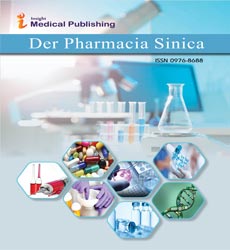ISSN : 0976 - 8688
Der Pharmacia Sinica
An Overview of Drug Metabolism
Prem K. Ramasamy*
Brandeis University, Oprian laboratory, Biochemistry Department, Waltham, MA
- *Corresponding Author:
- Prem K. Ramasamy
Brandeis University, Oprian laboratory, Biochemistry Department, Waltham, MA
E-mail: ramasamy@hotmail.com
Received Date: November 03, 2021; Accepted Date: November 17, 2021; Published Date:November 22, 2021
Citation: Ramasamy PK (2021) An Overview of Drug Metabolism. Der Pharmacia Sinica, Vol.12 No. 6: 18.
In Phase I, various enzymes introduce reactive and polar groups into the substrate. One of the most common modifications is hydroxylation, which is catalyzed by the cytochrome P450-dependent mixed function oxidase system. These enzyme complexes incorporate oxygen atoms into deactivated hydrocarbons and can lead to either introduction of hydroxyl groups or N-, O-, and S-dealkylation of the substrate. The reaction mechanism of P450 oxidase proceeds according to the following scheme through the reduction of cytochrome-bound oxygen and the formation of highly reactive oxypherine species. Phase I reactions (also known as non-synthetic reactions) can be carried out through oxidation, reduction, hydrolysis, cyclization, decyclization, addition of oxygen or removal of hydrogen, often in the liver. It is performed by an oxidase that has a mixing function. These oxidation reactions typically involve cytochrome P450 monooxygenase (often abbreviated as CYP), NADPH, and oxygen. Classes of drugs that use this method for metabolism include phenothiazines, acetaminophen, and steroids. If the metabolites of the Phase I reaction are sufficiently polar, they are easily excreted at this point. However, many Phase I products are not removed immediately, causing a secondary reaction in which the endogenous substrate binds to newly incorporated functional groups to form highly polar conjugates. Typical Phase I oxidation involves converting CH bonds to COH. This reaction may convert a pharmacologically inert compound (prodrug) into a pharmacologically active compound. Phase I can also convert non-toxic molecules into toxic molecules (addiction). Simple hydrolysis in the stomach is usually a harmless reaction, with exceptions. For example, Phase I metabolism converts acetonitrile to HOCH2CN, which quickly dissociates into formaldehyde and hydrocyanic acid. Phase I metabolism of drug candidates can be simulated in the laboratory using non-enzyme catalysts. This example of a biomimetic reaction tends to yield products that often contain Phase I metabolites. As an example, desmethyltrimebutine (nortrimebutine), the major metabolite of the drug trimebutine, can be efficiently produced by in vitro oxidation of over-the-counter drugs. Hydroxylation of N-methyl groups leads to the emission of formaldehyde molecules, but oxidation of O-methyl groups occurs to a lesser extent.
Oxidation
• Cytochrome P450 mono oxygenase system
• Flavin-containing mono oxygenase system
• Alcohol dehydrogenase and aldehyde dehydrogenase
• Monoamine oxidase
• Co-oxidation by peroxidases
Reduction
NADPH cytochrome P450 reductase, cytochrome P450 reductase, also known as NADPH: ferremoprotein, oxidoreductase, NADPH: hemo protein oxido reductase, NADPH: P450 oxidoreductases, P450 reductase, POR, CPR, and CYPOR are required for electron transfer from P450 to microsomes. It is an enzyme. Eukaryotic cells from the enzyme NADPH containing FAD and FMN: The general scheme of electron flow in the cytochrome P450 reductase POR / P450 system is as follows: NADPH → FAD → FMN → P450 → O2
Reduced (ferrous) cytochrome P450
During reduction reactions, a chemical can enter futile cycling, in which it gains a free-radical electron, then promptly loses it to oxygen (to form a superoxide anion).
• Hydrolysis
• Esterases and amidase
• Epoxide hydrolase
Phase II – conjugation
In subsequent Phase II reactions, these activated xenobiotic metabolites bind to charged species such as glutathione (GSH), sulfate, glycine, or glucuronic acid. The site of the drug where the conjugation reaction takes place includes carboxy (COOH), hydroxy (OH), amino (NH2), and thiol (SH) groups. The products from the binding reaction tend to be less active than the substrate, in contrast to the Phase I reaction, which has an increased molecular weight and often produces active metabolites. The addition of large anionic groups (such as GSH) detoxifies reactive electrophiles and prevents them from diffusing through the membrane, producing polar metabolites that can be actively transported. These reactions are catalyzed by a large group of transferases with broad specificity that can be metabolized in combination with almost any hydrophobic compound, including nucleophilic or electrophilic groups.
Open Access Journals
- Aquaculture & Veterinary Science
- Chemistry & Chemical Sciences
- Clinical Sciences
- Engineering
- General Science
- Genetics & Molecular Biology
- Health Care & Nursing
- Immunology & Microbiology
- Materials Science
- Mathematics & Physics
- Medical Sciences
- Neurology & Psychiatry
- Oncology & Cancer Science
- Pharmaceutical Sciences
